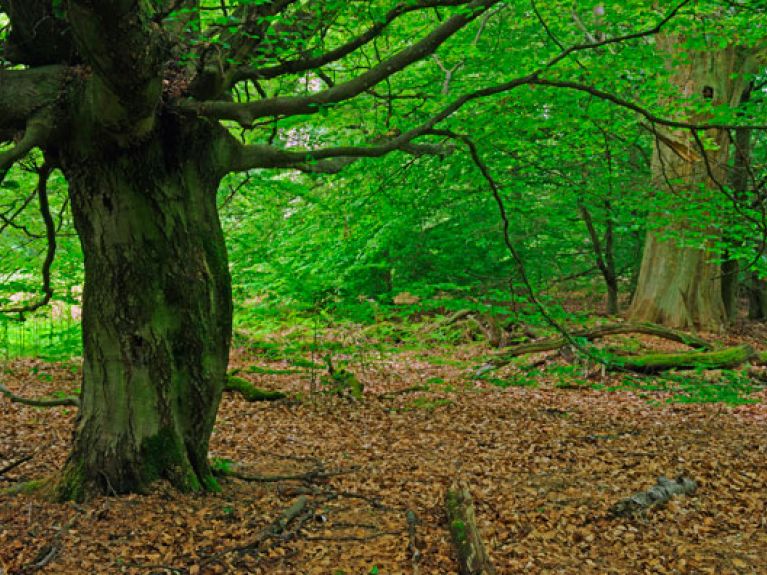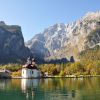The wonderful world of the forest
It is an economic factor, a power station for the climate and a fascinating, multi-faceted natural environment – insights into the German forest.

Germany is a land of forests. A third of this densely populated industrial country is covered by woodland. There is 11.1 million hectares or almost 43,000 square miles of it – an area that has remained constant since the beginning of the 16th century. Hard to believe? Just list the most famous and largest German forests and the figure immediately becomes plausible. Density populated urban and industrial regions are interspersed with great islands of green, whether it be the Black Forest or the Harz, the Fichtel Mountain Range, the Thuringian or Palatinate Forest. The largest continuously forested area in Central Europe is the Bavarian Forest, which furthermore links up with the Bohemian Forest in the Czech Republic. This is also where you will find Germany’s largest national park, covering an area of over 12,000 hectares (46 square miles). It too merges with the Czech national park across the common border. Together they form the largest forest reserve in Central Europe.
At least 60 percent of German forests are covered by conifers, particularly spruce and pine. But among the deciduous trees it is not the once so highly praised “German oak” that holds first place, but the beech. Extensive beech forests, where the sunlight plays between the smooth, silver-grey trunks, are among Germany’s most beautiful landscapes. In the spring of 2011, UNESCO awarded World Natural Heritage status to five near-natural German beech forests full of gigantic old trees. These forests cover approx. 4,400 hectares (17 square miles). One of them is the 600-hectare (2.3-square-mile) Grumsin Forest in the Schorfheide-Chorin Biosphere Reserve just an hour’s drive north of Berlin in the south of the rural district of Uckermark. Visiting the Grumsin Forest is almost like time travel: you really notice that the Ice Age has left its mark here as you hike through a craggy terrain of hills and hollows. It could hardly have been better protected from clearance over the centuries, with bogs, ponds and lakes between the trees – a natural monument of wood and water. But it is not so pleasant for humans here all year round: mosquitoes attack the wayfarer as if to make sure that the reserve’s recent UNESCO fame doesn’t attract too many visitors.
The United Nations declared 2011 “The International Year of the Forests” to draw global attention to the immense importance of these habitats for our planet and humanity. Forests play an essential role in the Earth’s climatic and weather system. They regulate the natural water cycle and air exchange, they are enormous carbon stores and habitats of irreplaceable biodiversity in both fauna and flora. And more people are economically dependent on the forests than most of us think. The main aim of the International Year is to spread the knowledge of all these functions of the forests.
Public interest in the forests is high anyway in Germany. The Müritz National Park, for example, attracts over half a million visitors a year. In this International Year of the Forests their curiosity is catered for with a wealth of additional forest experiences. 5,000 events are taking place all over Germany under the aegis of the Federal Ministry of Food, Agriculture and Consumer Protection: hiking trips, guided tours of the forest, concerts, tree plantings. To close the year, the German Historical Museum in Berlin is opening an exhibition on 2 December, 2011, called: “The German Forest – A Cultural History”, showing the world of the forest in literature and painting, a staged and at times overloaded “ideal picture of nature” (open until 4 March, 2012).
The Germans are probably so forest-conscious because they use the “green lung” extensively for recreation and sport. According to a survey, 50 percent of people in Germany spend time in the forest at least once every two weeks. Whether it’s jogging, hiking or strolling, they seek relaxation here from the hectic daily grind. What scientists would refer to the unique forest climate, they simply call “getting some fresh air”: protection against sun and noise, a pleasant level of humidity and much more.
Around 15 percent of German woodland consists of beech; just under ten percent of it is oak. The botanists are fairly certain that, but for human intervention, the beech would cover almost the entire country (apart from the mountainous regions). The dominance of conifers – spruce (28 percent) and pine (23 percent) – is man-made. The spruce’s high annual growth and its suitability for many uses promised rich timber harvests and quick profits. This led to the infamous monocultures, which were, however, also particularly susceptible to storm damage, disease and pests. But a change of approach aimed at minimizing the risk has already begun in the German forests. Afforestation is increasingly focusing on deciduous trees to increase the proportion of mixed forests. This is a challenging task for the forestry industry, since the already recognizable and future consequences of general climate change have to be taken into account in the choice of tree species. One thing that seems certain today is that the spruce will lose ground, since it comes under too much stress during extended periods of drought and heat. Beech, pine and oak are much hardier under such conditions.
How German woodland is faring is established every year in the Forest Status Reports and Federal Forest Inventories. The percentage of badly damaged trees (with thinning crowns) is especially high amongst beech and oak. Although the forest dieback feared in the 1980s did not occur, vigilant observation of the trees remains essential. More than ever, the forest has become a subject for science – whether to determine the effects of air pollution and over-fertilization, or to research processes in the forest soil or the behaviour of microbacteria and fungi.
Moreover, the forest is an important economic factor. Forestry and timber are among the largest sectors of the German economy. A headcount of about 1.2 million and an annual turnover of 170 billion euros are astonishing figures. Germany is among the most densely wooded countries in Europe. Every second, the trees here produce the equivalent of a wooden cube with an edge length of 1.55 metres. German forests are not overused, and growth exceeds the harvest, so that reserves are still available for wood-based power generation. The ways in which the forests are used could soon change significantly. Wood is at the focus of attention, particularly in the context of climate change. Its increased use in construction, energy generation in biomass power stations, wood-fired heating and many consumer goods can and should help improve the carbon balance. As an energy source, wood offers all the advantages of a renewable resource. If these aims are implemented, we can expect a significant increase in the demand for wood. It will be no easy task then to simultaneously meet the demands of forest and nature conservation, to maintain sufficient protected woodland and leave enough deadwood in the forest for worms, beetles and insects. Fortunately, sustainable forest and timber management does not have to be invented: it has been around for 300 years. The term was coined in 1713 by the Saxon mining administrator Hans Carl von Carlowitz.
Forests, both in Germany and worldwide, will be among the important working areas of the future. However, trees have a different timescale from humans; they grow over decades and centuries. This means that fundamental decisions have to be made today. Wood has become a complicated subject. The best cure that can be recommended for those who “can’t see the wood for the trees” is to seek relaxation and orientation by taking an extensive walk – between the tree trunks beneath the protective roof of a beech forest.

